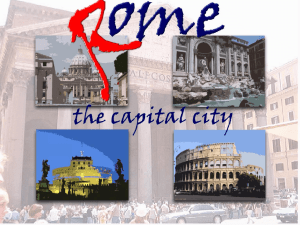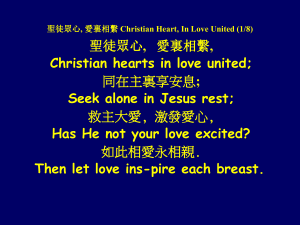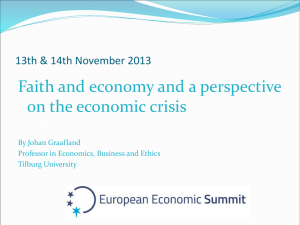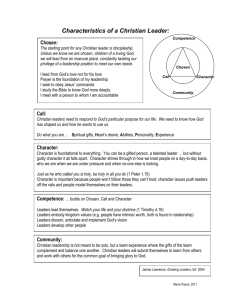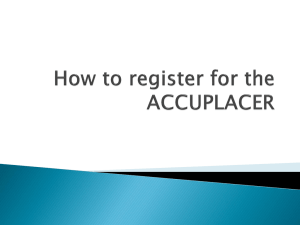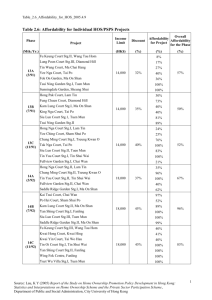12C The Church`s Story
advertisement
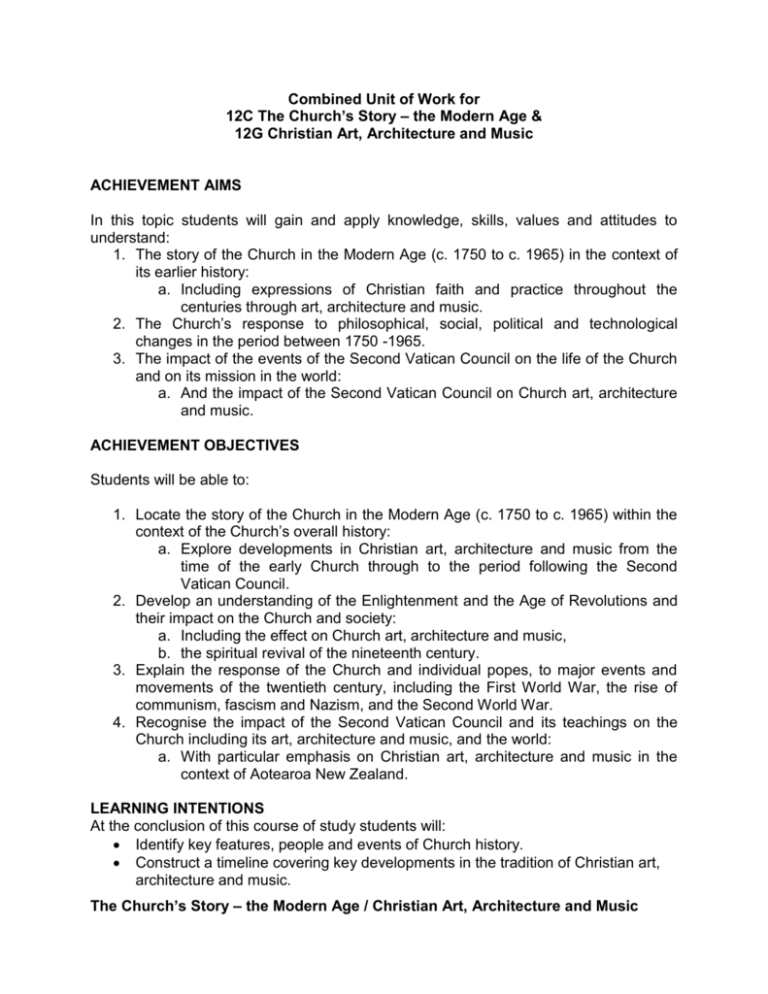
Combined Unit of Work for 12C The Church’s Story – the Modern Age & 12G Christian Art, Architecture and Music ACHIEVEMENT AIMS In this topic students will gain and apply knowledge, skills, values and attitudes to understand: 1. The story of the Church in the Modern Age (c. 1750 to c. 1965) in the context of its earlier history: a. Including expressions of Christian faith and practice throughout the centuries through art, architecture and music. 2. The Church’s response to philosophical, social, political and technological changes in the period between 1750 -1965. 3. The impact of the events of the Second Vatican Council on the life of the Church and on its mission in the world: a. And the impact of the Second Vatican Council on Church art, architecture and music. ACHIEVEMENT OBJECTIVES Students will be able to: 1. Locate the story of the Church in the Modern Age (c. 1750 to c. 1965) within the context of the Church’s overall history: a. Explore developments in Christian art, architecture and music from the time of the early Church through to the period following the Second Vatican Council. 2. Develop an understanding of the Enlightenment and the Age of Revolutions and their impact on the Church and society: a. Including the effect on Church art, architecture and music, b. the spiritual revival of the nineteenth century. 3. Explain the response of the Church and individual popes, to major events and movements of the twentieth century, including the First World War, the rise of communism, fascism and Nazism, and the Second World War. 4. Recognise the impact of the Second Vatican Council and its teachings on the Church including its art, architecture and music, and the world: a. With particular emphasis on Christian art, architecture and music in the context of Aotearoa New Zealand. LEARNING INTENTIONS At the conclusion of this course of study students will: Identify key features, people and events of Church history. Construct a timeline covering key developments in the tradition of Christian art, architecture and music. The Church’s Story – the Modern Age / Christian Art, Architecture and Music Summarise the scientific and philosophical aspects of the Enlightenment and its challenges to the Church. Reflect on themes and images the art of the Enlightenment. Define the important concepts associated with the Age of Revolutions. Reflect on themes and images the art of the Age of Revolutions. Identify the growth and development of popular spiritual practices and devotions in the nineteenth century. Identify features of the neo-Classical and neo-Gothic revivals and locate examples of them. Explain the influence of early Christian settlers on the art and music of Māori. Identify the role of Church hierarchy as articulated in the First Vatican Council. Describe the impact of the First World War on the Church and the world. Outline and explain the Church’s response to the major movements of the twentieth century. Recognise the social, political and religious issues and movements between Vatican I and Vatican II. Identify liturgical changes that came about as a result of the Second Vatican Council and how these influenced Church art, architecture and music. ASSESSMENT The course work lends itself to being assessed through AS 90821 Religious Studies 2.2 Explain the changes in an expression of a religious tradition. EG: Explain and analyse using a range of details and reasons with a range of examples to support your answers to explain the changes in architectural expression of the Catholic tradition as a result of the Second Vatican Council. KEY IDEAS (material that would need to be covered so that the achievement objectives are met) Students will be able to: 1. Locate the story of the Church in the Modern Age (c. 1750 to c. 1965) within the context of the Church’s overall history. a. Explore developments in Christian art, architecture and music from the time of the early Church through to the period following the Second Vatican Council The early Church. Byzantine movement. Romanesque period. Gothic. Renaissance. Reformation. Baroque/Rococo. Neo-classical and neo-Gothic revivals. The Church’s Story – the Modern Age / Christian Art, Architecture and Music Modern. 2. Develop an understanding of the Enlightenment and the Age of Revolutions and their impact on the Church and society: a. Including the effect on Church art, architecture and music, b. The spiritual revival of the nineteenth century. Faith and reason. Political authority. The Common Good. Church and society. Popular devotions of the nineteenth century. Church authority. 3. Explain the response of the Church and individual popes, to major events and movements of the twentieth century, including the First World War, the rise of communism, fascism and Nazism, and the Second World War: War and peace. Totalitarianism. Genocide. The pontificates of the twentieth century. 4. Recognise the impact of the Second Vatican Council and its teachings on the Church including its art, architecture and music, and the world: a. With particular emphasis on Christian art, architecture and music in the context of Aotearoa New Zealand. Māori culture and the Gospel. European settler faith. The arts and the Second Vatican Council. Buildings for divine worship. Liturgical singing and music. Possible lesson focus: This is based on 28 hour periods prior to assessment. It works with only one of the student text books at a time although for the middle period of the cycle having both sets of student books for a class would be preferable so that they can engage with the modern age and the art of its time. It would however, be desirable that the teacher has access to both teacher guides; 12C and 12G throughout the teaching and learning cycle. An integrated approach is required so that the material covered in the second stage of the programme is linked back to the appropriate material in the first topic. The Church’s Story – the Modern Age / Christian Art, Architecture and Music It is presumed that the teacher has read the two teacher guides for the two topics and is familiar with the overall learning intentions and content of the programme of teaching and learning. STC refers to the student text 12C: The Church’s Story – the Modern Age. STG refers the student text 12G: Christian Art, Architecture and Music. TGC refers to the teacher guide for 12C. TGG refers to the teacher guide for 12G. Lesson Coverage Art, architecture and music in the Christian tradition – general ideas and 1-3 concepts STG 2-4, 7-8, TGG 4-6, 8-14, 29-31 Art expressing the Christian story STG 4-7 Art through the ages The first centuries STG 9-12, TGG 15, 36-41 The Edict of Milan STG 13-15, TGG 15-16, 48-51 The Byzantine movement STG 16 -18, TGG 58-68 4-13 Romanesque influences STG 19-22, TGG 17, 71-89 Gothic expressions STG 23 -25, TGG 90-120 The Renaissance STG 25-28, TGG 121-135 The impact of the Reformation STG 29-32, TGG 18, 136-146 Art in the modern area The influence of a rapidly changing world STG 33, TGG 149-151 Rejection of religion, the role of science STC 5-8 14-15 The impact of revolutionary movements STC 9-11, 20-23 The development of personal piety and spiritual devotions STG 34 -34 STC 12, 15-16, TGG 18, 147-149 The twentieth century The First World War STC 24-25 Totalitarian states and philosophies between the wars STC 26-29 16 -19 The Second World War STC 30-32 Popes of the twentieth century STC 34 Aotearoa and its art Māori spirituality and art STG 38-39, TGG 6,19-20, 154-157 20-22 The influence of the settler Christians STG 30-42, STC 17-19, TGG 157167 The Second Vatican Council The need for the Church to re-express itself and its relationship to the world STC 33, 35-36 23-28 The Council and its 16 documents STC 37-39 Liturgical changes STG 44-45, TGG 21-25, 172-184, 186-202 The Church’s Story – the Modern Age / Christian Art, Architecture and Music Art as an expression of the human spirit The Church’s Story – the Modern Age / Christian Art, Architecture and Music


![[PowerPoint 2007] presentation file](http://s2.studylib.net/store/data/005406460_1-7834316c409f9802f7aec3d8538324fb-300x300.png)
